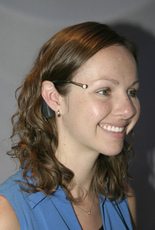Sep 6 2007
Scientists have long known that the human body runs like clockwork, guided by a circadian system that responds to daily patterns of light and darkness. Now a team of researchers is developing a personal device to measure daily light intake and activity, which could allow them to predict optimal timing for light therapy to synchronize the circadian clock to the 24-hour solar day and relieve psychosocial stress.
 By wearing this small, wireless device being developed by scientists in Rensselaer's Lighting Research Center, users can monitor their daily rest and activity pattern as well as exposure to circadian light. The tool will have the capacity to communicate with the user in real-time to give immediate feedback regarding proper light exposure to promote a synchronized circadian rhythm.
By wearing this small, wireless device being developed by scientists in Rensselaer's Lighting Research Center, users can monitor their daily rest and activity pattern as well as exposure to circadian light. The tool will have the capacity to communicate with the user in real-time to give immediate feedback regarding proper light exposure to promote a synchronized circadian rhythm.
In short, scientists are creating a tool to help people literally “lighten up.”
Inadequate or irregular light exposure – something many individuals face on a regular basis – can cause circadian rhythm disruptions that can manifest into sleep and stress-related ailments. Supported by a $1.8 million grant from the National Institutes of Health (NIH), researchers in Rensselaer Polytechnic Institute’s Lighting Research Center (LRC) are creating a small, head-mounted device to measure an individual’s daily rest and activity patterns, as well as exposure to circadian light – short-wavelength light, particularly natural light from the blue sky, that stimulates the circadian system.
The wireless tool will have the capacity to communicate with the user in real-time to give immediate feedback regarding proper light exposure to promote a synchronized circadian rhythm, according to Mark Rea, director of the LRC and principal investigator on the project.
Like a clock that needs to be set daily for accurate time-telling, the circadian clock – an internal regulating mechanism that controls the repetition of biological activities such as core body temperature variations, hormone production and secretion, and sleeping and waking patterns, among other functions in the human body – requires similar “setting” from the light each day. A cycle of very bright days and very dark nights is the perfect regulator for the human circadian system, but patterns of light and dark in today’s modern world are often inconsistent with this cycle.
The advent of electricity has dramatically changed our light and dark exposure patterns, and indoor lighting can be insufficient to stimulate the circadian clock, Rea said. Exposure to indoor light sources during the night, including computer screens, may be too bright or seen for too long, to properly set the timing of the circadian clock. These disruptions can desynchronize the circadian rhythm from the solar daytime/nighttime cycle, leading to sleep problems and psychosocial stress such as mood and eating disorders, depression, and possibly immune deficiencies.
“Outdoor light levels during the day – even under cloud cover or during the winter – are of much higher levels than those found in windowless, electrically illuminated buildings, and this absence of suitable light may induce ‘circadian darkness,’” Rea said. “If an individual’s circadian light intake is deficient during waking hours, our device will be able to reliably predict the light therapy necessary to resynchronize the circadian phase with the solar day.”
Such treatments could range from standing outside for 15 minutes to sitting in front of a light box fitted with blue LEDs for a certain amount of time, says Rea.
Rea and his colleague Mariana Figueiro, assistant professor in the LRC and co-PI on the project, will collaborate with scientists from Brown and Yale universities on a study to uncover participants’ baseline circadian rhythms by collecting information regarding each person’s sleeping and waking cycles, light intake, and fluctuations in sleep quality, stress markers, and gene expression, which are all controlled by the circadian rhythm. Then, using light therapy treatment, the team will attempt to shift each participant’s circadian phase.
The results of the study will provide scientists in the LRC with the information they need to determine the level of accuracy required for the new device to accurately predict light-induced shifting of the circadian phase, according to Figueiro.
Additionally, monitoring each participant’s genes before, during, and after the light therapy may help the researchers determine whether or not light exposure can express or silence genes influenced by the circadian system, an emerging area of interest to the circadian and cancer research communities who have begun to focus on the possibility that our circadian clock controls the expression of a wide variety of genes, including many cancer-related genes.
Once developed, the new light monitoring and therapy prediction device has the potential to positively affect the lives of millions who suffer from circadian rhythm sleep disorders. Among others, potential populations that could benefit from the tool include college students, who experience a delayed sleep phase and go to bed and arise later than most people; international business travelers who suffer from jet lag; and shift workers who are often active at times opposite the solar day, according to the researchers.